Chef Conor Spacey is culinary director of FoodSpace Ireland. FoodSpace caters – mainly in professional settings – throughout Ireland and focuses on from-scratch, ethically sourced foods. Conor is heavily involved in the Chef’s Manifesto, which is an action plan based on the idea that chefs should be advocates for sustainable food systems. Conor was among the first to ban avocados from being used in his catering spaces due to the ethical and environmental problems with their production. After much deliberation, he also banned products containing palm oil. Now, he is about to publish his first cookbook under the Blasta Books series, called Wasted.

As an active member of the Chef's Manifesto, Conor is an advocate for sustainable and ethical food systems \ Philip Doyle
We caught up with Conor in a space he is familiar with – Grow HQ in Waterford, which is the home base for the Irish chapter of Chef’s Manifesto and is where his good friend, JB Dubois, cooks with similar zero-waste principles.
Wasted, which will be out on 27 July, takes a look at the most commonly wasted foods in our households and provides smart, accessible recipes to help people begin the process of combatting it.
“We know most of the waste which occurs in people’s homes comes from people not knowing what to do with something,” Conor explains. “So the book identifies the most wasted products or food items we have at home. It aims to provoke change.”
While most consumers are aware that food waste is an issue, many are time poor and don’t have the same skillset as a trained chef. Conor says it’s important to be understanding and practical, as well, when it comes to managing household food waste.
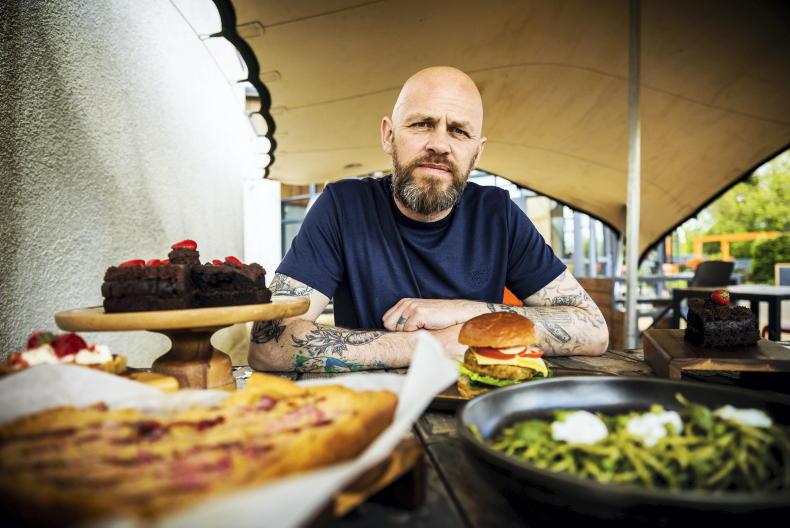
Conor believes most household food waste stems from people not knowing how to use the whole ingredient \ Philip Doyle
“Previous generations – our parents, for example – had more time, so the main meal was once a day with everyone sitting around the table and the food was the centrepiece. That’s gone now – we need quick meals, we are eating more processed food and producing lots of waste. The book shares recipes that can fit into your lifestyle.”
One of the top tips Conor has for minimising the food waste in your life is a relatively simple one: fall back in love with your freezer.

Conor's cookbook 'Wasted' will be released on 27 July under the Blasta Books series \ Philip Doyle
“Forget the goujons and pizzas - freezers were never built for that; they were built for preservation,” he states. “Start saving things – like your veggie skins – and freezing them to use for future soups, sauces or other recipes.”
You can preorder Wasted at blastabooks.com (€15). In the meantime, Conor has shared some additional recipes which tackle household food waste with Irish Country Living.
Green spaghetti with homemade ricotta
Serves four
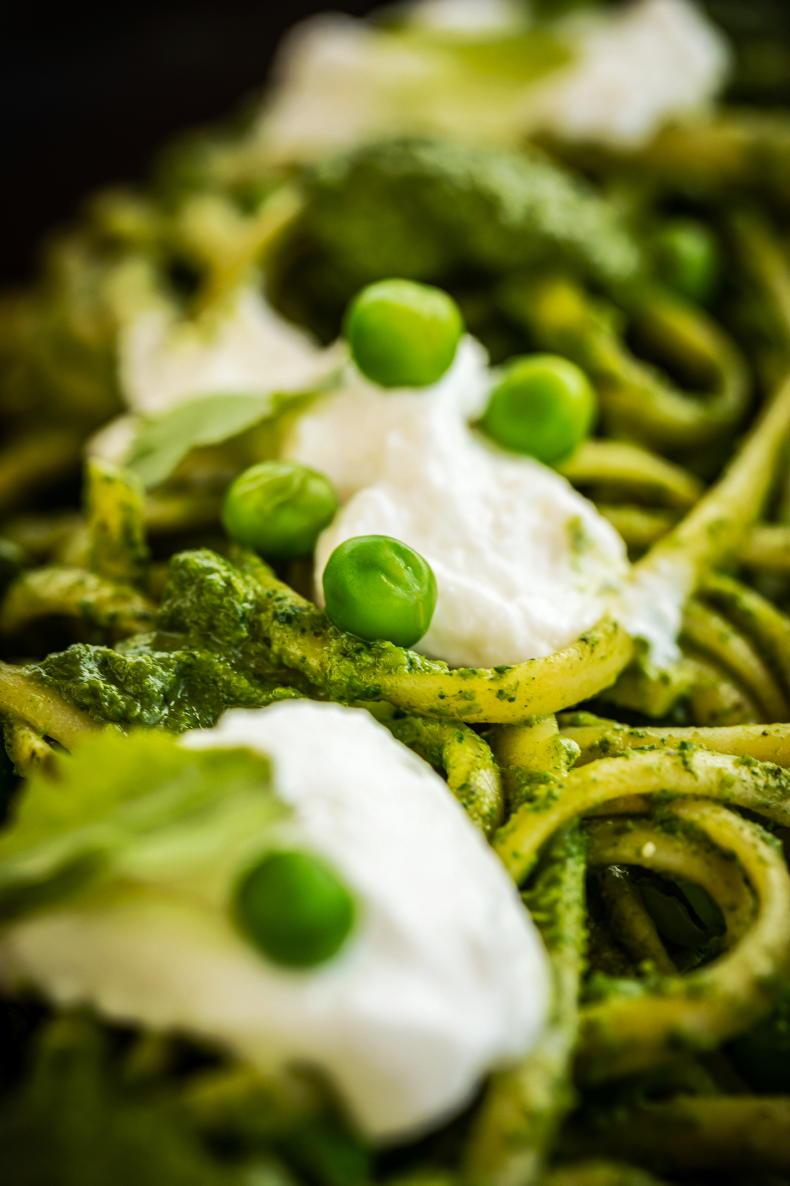
Green spaghetti with homemade ricotta \ Philip Doyle
Did you know that one in six litres of milk goes to waste in Ireland? Here is a simple way to make your own cheese at home, with milk which might be over its use by date by one to two days. It’s a great addition to pastas, casseroles, salads and dips. This vibrantly tasty pasta is a great way to use your green herbs and veggies which have seen better days.
For the ricotta
1 litre surplus/expired milk
Juice of one lemon
80ml of any vinegar
1 tsp salt
For the spaghetti
400g spaghetti
100g bag baby spinach
140g frozen peas
50g (a small bunch) basil or parsley
4 tbsp green pesto
150ml cream
1 recipe homemade ricotta cheese
Green peas, for garnish
Basil leaves, for garnish
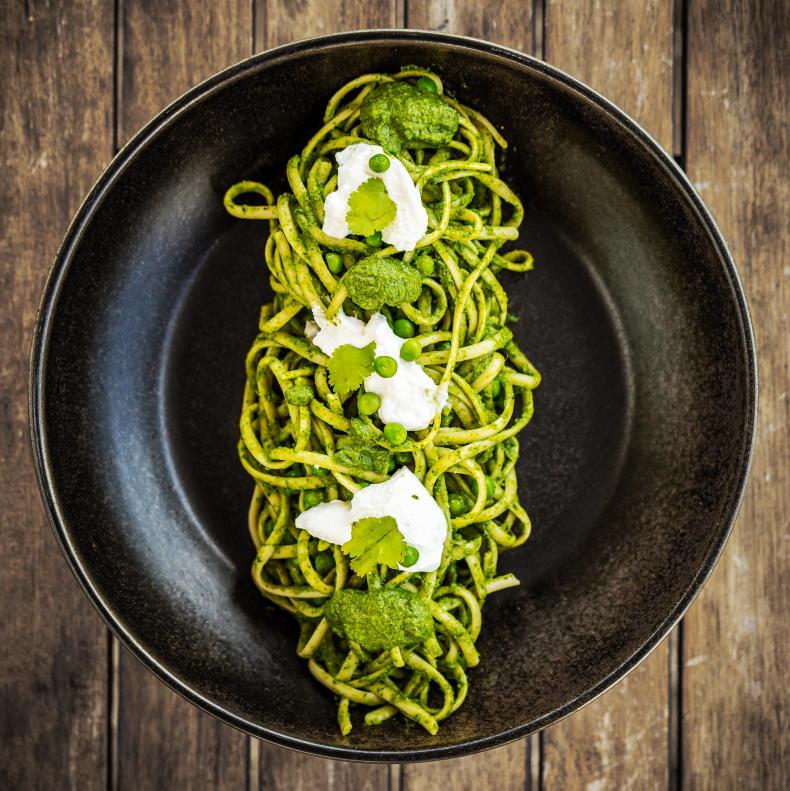
Green spaghetti with homemade ricotta \ Philip Doyle
1 Make the ricotta: slowly heat your milk in a pot until it begins to foam, but not boil (just before the boiling point is reached, about 95°C, if using a thermometer). Remove from the heat and add the lemon juice, vinegar and salt.
2 Leave it in the pot to stand for 10 minutes. The curds will separate from the whey during this time. Pour the cheese curds and liquid through a sieve lined with muslin to catch the curds.
3 Leave the curds in the muslin-lined sieve for 30 minutes to strain. Then, keep the ricotta in your fridge for up to a week (you can also save the liquid to make homemade pizza dough).
4 Make the spaghetti: cook the pasta following pack instructions. Place the spinach and peas in a large bowl and cover with freshly boiled water. Let sit for two to three minutes, until the peas are tender, then strain.
5 Place the spinach and peas in a blender and add the basil, pesto and cream. Blend to make a smooth sauce.
6 Drain the pasta, keeping a cup of the cooking water, and add the pasta to a large pan. Pour over the sauce and cook at a low heat for a few minutes, tossing and mixing the pasta with tongs until it is completely coated in the sauce. Add a little pasta water to make it creamy, then crumble in the homemade ricotta.
7 Stir everything through and serve on warmed plates with fresh bread or a light salad. Garnish the pasta with whole green peas and fresh basil leaves.
Spiced chickpea burgers
with aquafaba sauce
Serves four
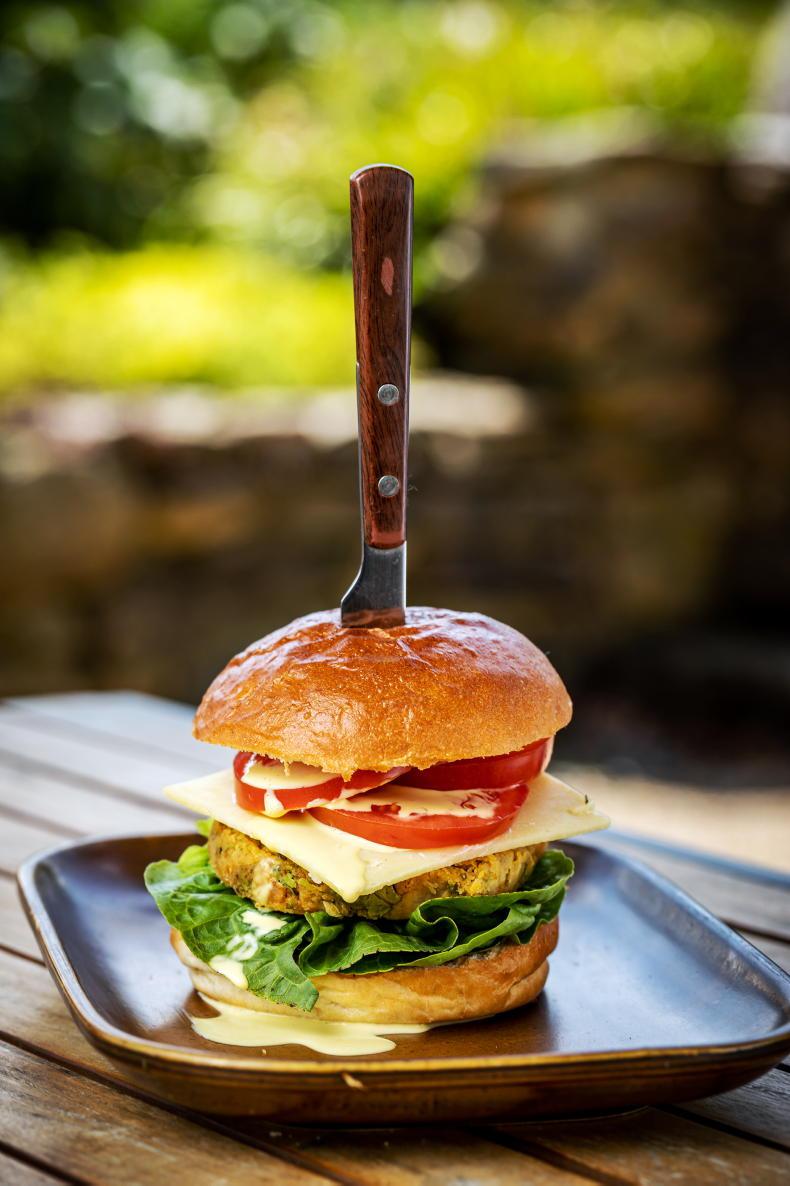
Spiced chickpea burgers with aquafaba sauce \ Philip Doyle
These days, most of us have a can of chickpeas hanging around the cupboard, and this is a great recipe for the evenings you’ve forgotten to take something out of the freezer for dinner. Increasing your consumption of beans and legumes is great for your health and the planet, but this recipe works equally well with Irish minced beef, lamb or turkey. If you have leftover chickpea mixture, you can shape it into balls, freeze and then bake or fry as needed to make falafels.
2 x 400g tinned chickpeas
(keep the chickpea water to make the burger sauce)
50g or one handful fresh coriander (including stalks)
½ tsp paprika
½ tsp ground coriander
2 tsp sea salt
½ tsp ground cumin
Juice and rind of one lemon
3 heaped tbsp plain flour, plus extra for dusting
Irish rapeseed oil (for frying)
1 head of Irish gem lettuce
(save the root to regrow)
2 large, ripe tomatoes
4 slices cheddar cheese
4 brioche buns
For the burger sauce
60ml chickpea liquid
(also called aquafaba)
1/2 tsp cream of tartar
1/2 tsp salt
1 tsp apple cider vinegar
1/2 tsp Dijon mustard
200ml sunflower oil
(or any mild tasting oil)

Spiced chickpea burgers with aquafaba sauce \ Philip Doyle
1 Drain the chickpeas, retaining the liquid, and add them into a food processor. Add half coriander leaves and stalks.
2 Add the spices, flour and the sea salt, then finely grate in the lemon zest and add the lemon juice. Blend until combined, but not too smooth – you want a bit of texture.
3 On a floured surface, divide and shape the chickpea mixture into four equal-sized burger patties. Place in the fridge for 30 minutes to firm up.
4 While they are chilling, make the burger sauce: add the chickpea liquid to a tall, narrow container (like a pitcher or large measuring jug). Add the salt, cream of tartar, apple cider vinegar and Dijon.
5 Blend this mixture for three to five minutes, until light and foamy. Then, continuing to blend, add the oil very slowly, in a thin trickle, until the sauce thickens (you may not need to add all of the oil). Check for seasoning and keep in the fridge for up to two weeks in an airtight container.
6 Heat a good splash of rapeseed oil in a large frying pan over a medium heat. Add the chickpea patties and cook for 10 minutes, or until golden and cooked through, turning halfway.
7 Chop the remainder of the coriander and add to the burger sauce.
8 Toast the buns in a pan or grill and squeeze a large dollop of burger sauce onto the base of each bun, then top with lettuce and a burger patty. Top with a couple of slices of tomato, cheese and the burger bun top.
7 Serve hot. These burgers are delicious served with a fresh green salad.
“The whole strawberry” blondies
Makes 12 blondies
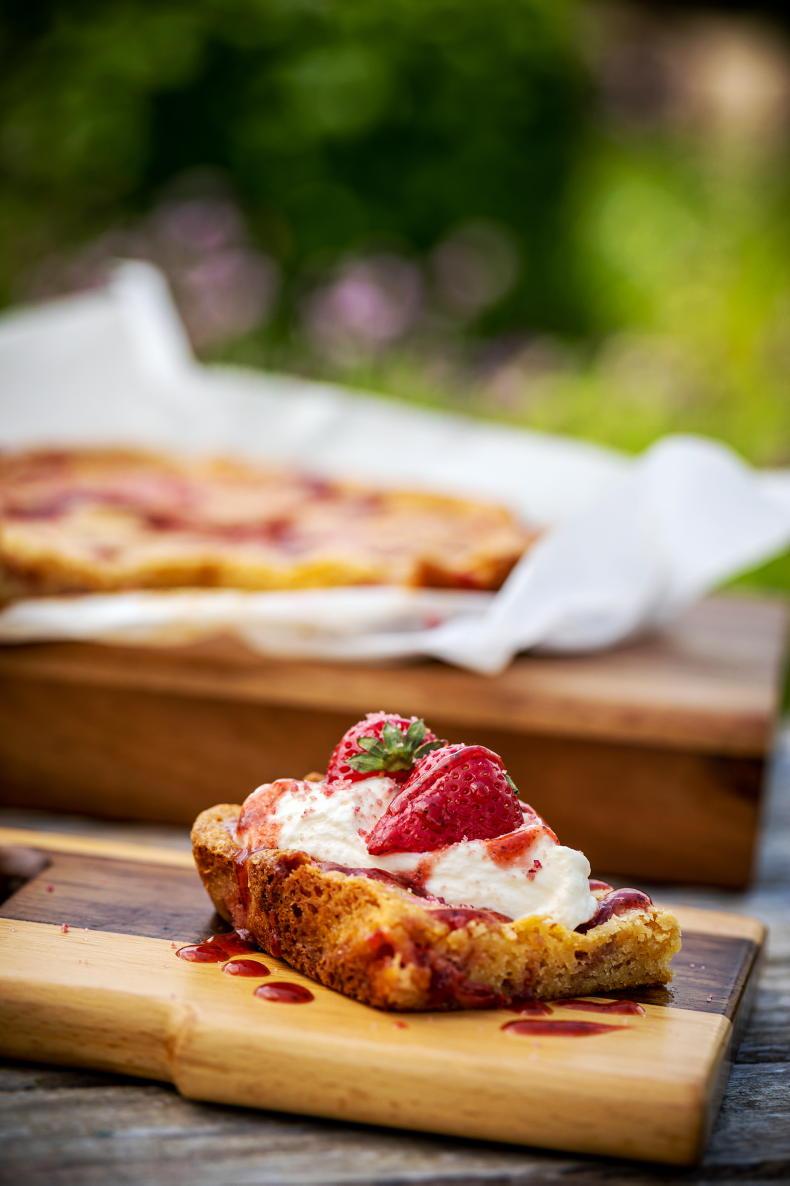
Strawberry Blondies \ Philip Doyle
A great way to use the whole strawberry – tops and all. Sometimes we don’t eat strawberries quickly enough and they go soft very quickly. In this recipe, the berries are used in the blondies and the tops are blended to make a delicious sauce. Both the sauce and the blondies can be frozen for up to four weeks.
180g white chocolate
115g butter
100g caster sugar
2 free range eggs
½ tsp vanilla
125g plain flour
1 small punnet Irish strawberries, hulled and sliced
For the strawberry coulis sauce
The tops and greens of the strawberries
3 Tbsp caster sugar
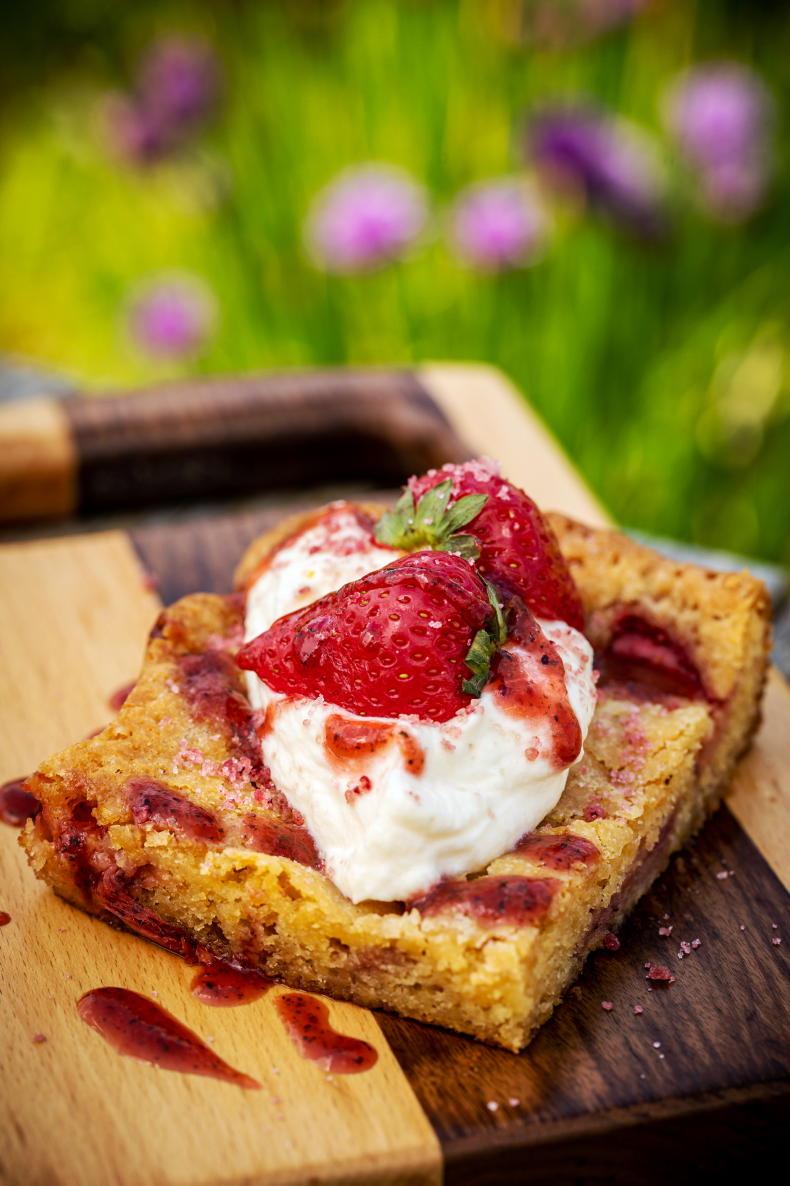
Strawberry Blondies \ Philip Doyle
1 Line an 8-10in square baking dish with parchment paper and set aside. Preheat the oven to 180°C.
2 Cut the butter into cubes and break up the white chocolate. Place both into a heat-proof bowl.
3 Set the bowl of butter and white chocolate over a pot of simmering water. Melt the white chocolate and butter until smooth, stirring frequently.
4 Remove the bowl from the pot of simmering water and stir in the caster sugar with a whisk.
5 Add the eggs and mix well to combine (do this quickly so they don’t scramble in the warm butter and chocolate), then add the vanilla and flour. Stir just until a batter is formed.
6 Pour the batter into the prepared baking pan, spreading it evenly. Add the sliced strawberries over top.
7 Bake in the preheated oven for 20-25 minutes, then remove from the oven and cool completely.
8 For the sauce, place the strawberry tops (including the greens) into a bowl and sprinkle with the sugar. Let this sit for 20 minutes and then puree in a food processor or blender.
8 Cut the blondies into squares and serve with fresh cream or ice cream and a drizzle of the strawberry coulis.
Triple chocolate
bread-box cake
Serves 6-8
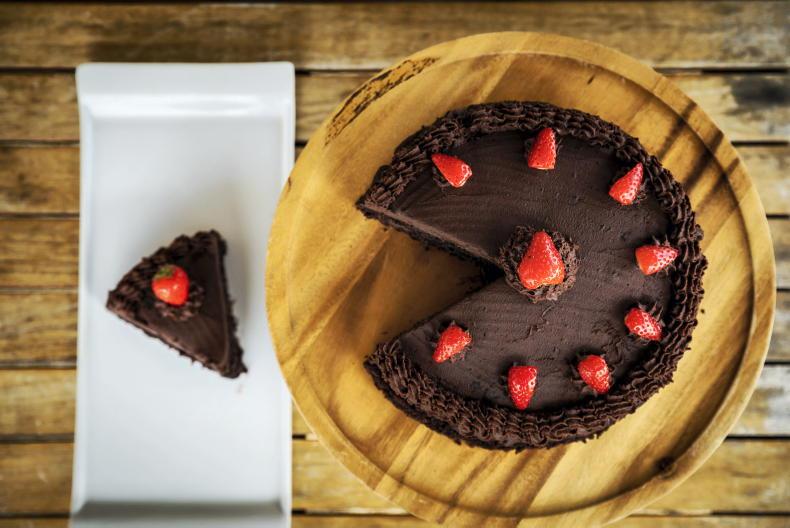
Triple chocolate bread-box cake \ Philip Doyle
This recipe is a great way to transform stale bread into a delicious treat. Bread is one of the most wasted items in our homes and – believe me – when you make this cake, you’ll never waste a slice again.
400g stale bread like sliced pan, batch loaf or brioche
10g baking powder
140g brown sugar
60g cocoa powder
2 large free range eggs
100g dark chocolate, chopped
300ml milk
1 tsp vanilla
For the ganache
300g dark chocolate, chopped
300ml cream
Fresh raspberries or strawberries, for garnish
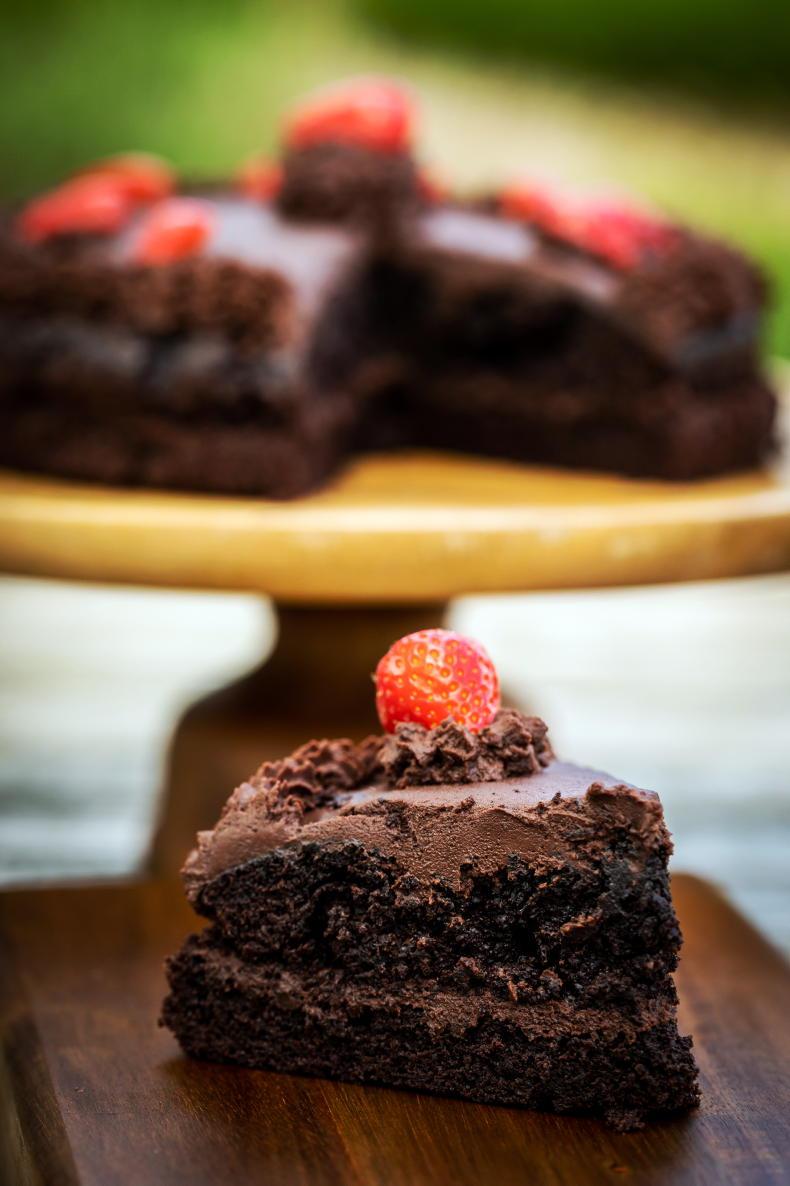
Triple chocolate bread-box cake \ Philip Doyle
1 Line an 8in cake tin with parchment paper and set aside. Preheat the oven to 150°C. Break the bread into pieces and add to a blender. Blend until it becomes bread crumbs.
2 Add the sugar, cocoa powder and baking powder to the blender with the bread and pulse until completely combined.
3 Continuing to use the blender, add the eggs, vanilla and milk and blend until the mixture becomes a cake batter.
4 Add the batter to the prepared cake tin and sprinkle over the chopped chocolate pieces. Bake in the preheated oven for 20-25 minutes, until a skewer inserted into the centre comes out clean.
5 Remove the cake from the oven and cool completely on a wire rack.
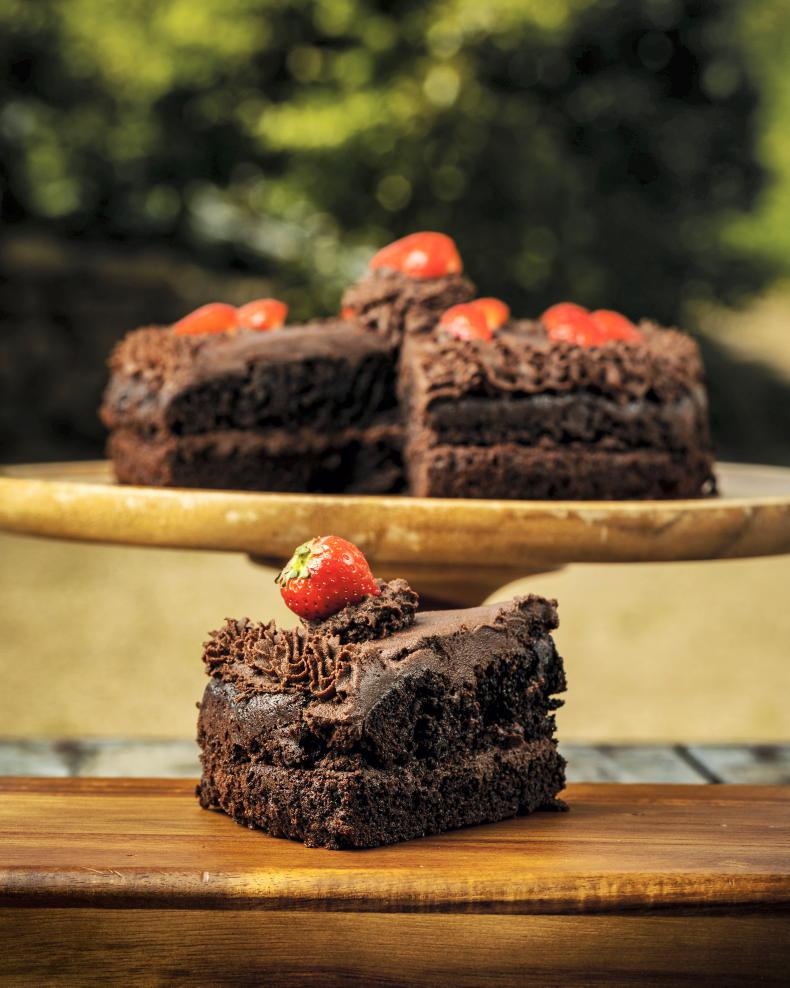
Triple chocolate bread-box cake \ Philip Doyle
6 Once it’s cooled, make the ganache: slowly heat your cream to a near boil (but don’t let it boil). Pour the hot cream over the chopped dark chocolate and let sit for two minutes.
7 Slowly whisk the cream and chocolate until completely combined. Allow the mixture to cool to room temperature.
8 Once cooled, pour the ganache over the cake to completely cover. Place in the fridge to set. Garnish with fresh berries and enjoy.
Read more
Causeway Coastal Christmas
Food editorial: a different perspective on old favourites
Chef Conor Spacey is culinary director of FoodSpace Ireland. FoodSpace caters – mainly in professional settings – throughout Ireland and focuses on from-scratch, ethically sourced foods. Conor is heavily involved in the Chef’s Manifesto, which is an action plan based on the idea that chefs should be advocates for sustainable food systems. Conor was among the first to ban avocados from being used in his catering spaces due to the ethical and environmental problems with their production. After much deliberation, he also banned products containing palm oil. Now, he is about to publish his first cookbook under the Blasta Books series, called Wasted.

As an active member of the Chef's Manifesto, Conor is an advocate for sustainable and ethical food systems \ Philip Doyle
We caught up with Conor in a space he is familiar with – Grow HQ in Waterford, which is the home base for the Irish chapter of Chef’s Manifesto and is where his good friend, JB Dubois, cooks with similar zero-waste principles.
Wasted, which will be out on 27 July, takes a look at the most commonly wasted foods in our households and provides smart, accessible recipes to help people begin the process of combatting it.
“We know most of the waste which occurs in people’s homes comes from people not knowing what to do with something,” Conor explains. “So the book identifies the most wasted products or food items we have at home. It aims to provoke change.”
While most consumers are aware that food waste is an issue, many are time poor and don’t have the same skillset as a trained chef. Conor says it’s important to be understanding and practical, as well, when it comes to managing household food waste.

Conor believes most household food waste stems from people not knowing how to use the whole ingredient \ Philip Doyle
“Previous generations – our parents, for example – had more time, so the main meal was once a day with everyone sitting around the table and the food was the centrepiece. That’s gone now – we need quick meals, we are eating more processed food and producing lots of waste. The book shares recipes that can fit into your lifestyle.”
One of the top tips Conor has for minimising the food waste in your life is a relatively simple one: fall back in love with your freezer.

Conor's cookbook 'Wasted' will be released on 27 July under the Blasta Books series \ Philip Doyle
“Forget the goujons and pizzas - freezers were never built for that; they were built for preservation,” he states. “Start saving things – like your veggie skins – and freezing them to use for future soups, sauces or other recipes.”
You can preorder Wasted at blastabooks.com (€15). In the meantime, Conor has shared some additional recipes which tackle household food waste with Irish Country Living.
Green spaghetti with homemade ricotta
Serves four

Green spaghetti with homemade ricotta \ Philip Doyle
Did you know that one in six litres of milk goes to waste in Ireland? Here is a simple way to make your own cheese at home, with milk which might be over its use by date by one to two days. It’s a great addition to pastas, casseroles, salads and dips. This vibrantly tasty pasta is a great way to use your green herbs and veggies which have seen better days.
For the ricotta
1 litre surplus/expired milk
Juice of one lemon
80ml of any vinegar
1 tsp salt
For the spaghetti
400g spaghetti
100g bag baby spinach
140g frozen peas
50g (a small bunch) basil or parsley
4 tbsp green pesto
150ml cream
1 recipe homemade ricotta cheese
Green peas, for garnish
Basil leaves, for garnish

Green spaghetti with homemade ricotta \ Philip Doyle
1 Make the ricotta: slowly heat your milk in a pot until it begins to foam, but not boil (just before the boiling point is reached, about 95°C, if using a thermometer). Remove from the heat and add the lemon juice, vinegar and salt.
2 Leave it in the pot to stand for 10 minutes. The curds will separate from the whey during this time. Pour the cheese curds and liquid through a sieve lined with muslin to catch the curds.
3 Leave the curds in the muslin-lined sieve for 30 minutes to strain. Then, keep the ricotta in your fridge for up to a week (you can also save the liquid to make homemade pizza dough).
4 Make the spaghetti: cook the pasta following pack instructions. Place the spinach and peas in a large bowl and cover with freshly boiled water. Let sit for two to three minutes, until the peas are tender, then strain.
5 Place the spinach and peas in a blender and add the basil, pesto and cream. Blend to make a smooth sauce.
6 Drain the pasta, keeping a cup of the cooking water, and add the pasta to a large pan. Pour over the sauce and cook at a low heat for a few minutes, tossing and mixing the pasta with tongs until it is completely coated in the sauce. Add a little pasta water to make it creamy, then crumble in the homemade ricotta.
7 Stir everything through and serve on warmed plates with fresh bread or a light salad. Garnish the pasta with whole green peas and fresh basil leaves.
Spiced chickpea burgers
with aquafaba sauce
Serves four

Spiced chickpea burgers with aquafaba sauce \ Philip Doyle
These days, most of us have a can of chickpeas hanging around the cupboard, and this is a great recipe for the evenings you’ve forgotten to take something out of the freezer for dinner. Increasing your consumption of beans and legumes is great for your health and the planet, but this recipe works equally well with Irish minced beef, lamb or turkey. If you have leftover chickpea mixture, you can shape it into balls, freeze and then bake or fry as needed to make falafels.
2 x 400g tinned chickpeas
(keep the chickpea water to make the burger sauce)
50g or one handful fresh coriander (including stalks)
½ tsp paprika
½ tsp ground coriander
2 tsp sea salt
½ tsp ground cumin
Juice and rind of one lemon
3 heaped tbsp plain flour, plus extra for dusting
Irish rapeseed oil (for frying)
1 head of Irish gem lettuce
(save the root to regrow)
2 large, ripe tomatoes
4 slices cheddar cheese
4 brioche buns
For the burger sauce
60ml chickpea liquid
(also called aquafaba)
1/2 tsp cream of tartar
1/2 tsp salt
1 tsp apple cider vinegar
1/2 tsp Dijon mustard
200ml sunflower oil
(or any mild tasting oil)

Spiced chickpea burgers with aquafaba sauce \ Philip Doyle
1 Drain the chickpeas, retaining the liquid, and add them into a food processor. Add half coriander leaves and stalks.
2 Add the spices, flour and the sea salt, then finely grate in the lemon zest and add the lemon juice. Blend until combined, but not too smooth – you want a bit of texture.
3 On a floured surface, divide and shape the chickpea mixture into four equal-sized burger patties. Place in the fridge for 30 minutes to firm up.
4 While they are chilling, make the burger sauce: add the chickpea liquid to a tall, narrow container (like a pitcher or large measuring jug). Add the salt, cream of tartar, apple cider vinegar and Dijon.
5 Blend this mixture for three to five minutes, until light and foamy. Then, continuing to blend, add the oil very slowly, in a thin trickle, until the sauce thickens (you may not need to add all of the oil). Check for seasoning and keep in the fridge for up to two weeks in an airtight container.
6 Heat a good splash of rapeseed oil in a large frying pan over a medium heat. Add the chickpea patties and cook for 10 minutes, or until golden and cooked through, turning halfway.
7 Chop the remainder of the coriander and add to the burger sauce.
8 Toast the buns in a pan or grill and squeeze a large dollop of burger sauce onto the base of each bun, then top with lettuce and a burger patty. Top with a couple of slices of tomato, cheese and the burger bun top.
7 Serve hot. These burgers are delicious served with a fresh green salad.
“The whole strawberry” blondies
Makes 12 blondies

Strawberry Blondies \ Philip Doyle
A great way to use the whole strawberry – tops and all. Sometimes we don’t eat strawberries quickly enough and they go soft very quickly. In this recipe, the berries are used in the blondies and the tops are blended to make a delicious sauce. Both the sauce and the blondies can be frozen for up to four weeks.
180g white chocolate
115g butter
100g caster sugar
2 free range eggs
½ tsp vanilla
125g plain flour
1 small punnet Irish strawberries, hulled and sliced
For the strawberry coulis sauce
The tops and greens of the strawberries
3 Tbsp caster sugar

Strawberry Blondies \ Philip Doyle
1 Line an 8-10in square baking dish with parchment paper and set aside. Preheat the oven to 180°C.
2 Cut the butter into cubes and break up the white chocolate. Place both into a heat-proof bowl.
3 Set the bowl of butter and white chocolate over a pot of simmering water. Melt the white chocolate and butter until smooth, stirring frequently.
4 Remove the bowl from the pot of simmering water and stir in the caster sugar with a whisk.
5 Add the eggs and mix well to combine (do this quickly so they don’t scramble in the warm butter and chocolate), then add the vanilla and flour. Stir just until a batter is formed.
6 Pour the batter into the prepared baking pan, spreading it evenly. Add the sliced strawberries over top.
7 Bake in the preheated oven for 20-25 minutes, then remove from the oven and cool completely.
8 For the sauce, place the strawberry tops (including the greens) into a bowl and sprinkle with the sugar. Let this sit for 20 minutes and then puree in a food processor or blender.
8 Cut the blondies into squares and serve with fresh cream or ice cream and a drizzle of the strawberry coulis.
Triple chocolate
bread-box cake
Serves 6-8

Triple chocolate bread-box cake \ Philip Doyle
This recipe is a great way to transform stale bread into a delicious treat. Bread is one of the most wasted items in our homes and – believe me – when you make this cake, you’ll never waste a slice again.
400g stale bread like sliced pan, batch loaf or brioche
10g baking powder
140g brown sugar
60g cocoa powder
2 large free range eggs
100g dark chocolate, chopped
300ml milk
1 tsp vanilla
For the ganache
300g dark chocolate, chopped
300ml cream
Fresh raspberries or strawberries, for garnish

Triple chocolate bread-box cake \ Philip Doyle
1 Line an 8in cake tin with parchment paper and set aside. Preheat the oven to 150°C. Break the bread into pieces and add to a blender. Blend until it becomes bread crumbs.
2 Add the sugar, cocoa powder and baking powder to the blender with the bread and pulse until completely combined.
3 Continuing to use the blender, add the eggs, vanilla and milk and blend until the mixture becomes a cake batter.
4 Add the batter to the prepared cake tin and sprinkle over the chopped chocolate pieces. Bake in the preheated oven for 20-25 minutes, until a skewer inserted into the centre comes out clean.
5 Remove the cake from the oven and cool completely on a wire rack.

Triple chocolate bread-box cake \ Philip Doyle
6 Once it’s cooled, make the ganache: slowly heat your cream to a near boil (but don’t let it boil). Pour the hot cream over the chopped dark chocolate and let sit for two minutes.
7 Slowly whisk the cream and chocolate until completely combined. Allow the mixture to cool to room temperature.
8 Once cooled, pour the ganache over the cake to completely cover. Place in the fridge to set. Garnish with fresh berries and enjoy.
Read more
Causeway Coastal Christmas
Food editorial: a different perspective on old favourites


















 This is a subscriber-only article
This is a subscriber-only article










SHARING OPTIONS: